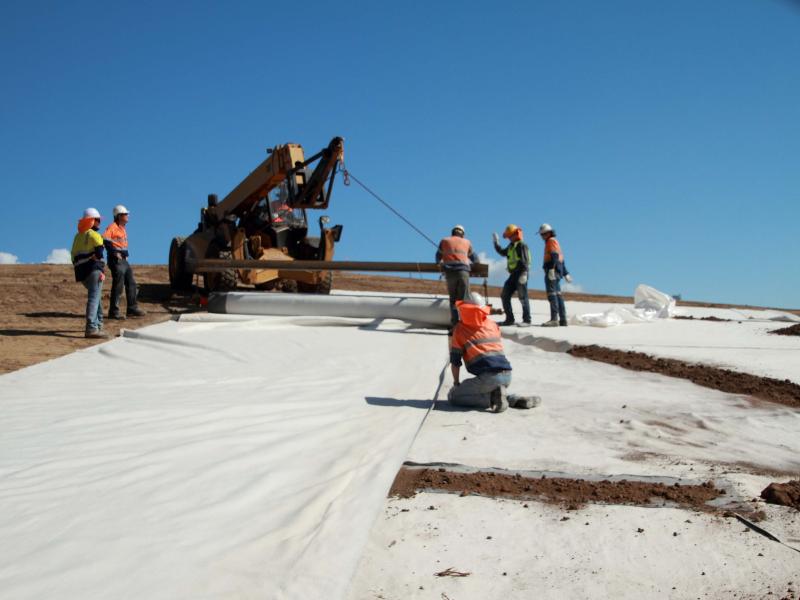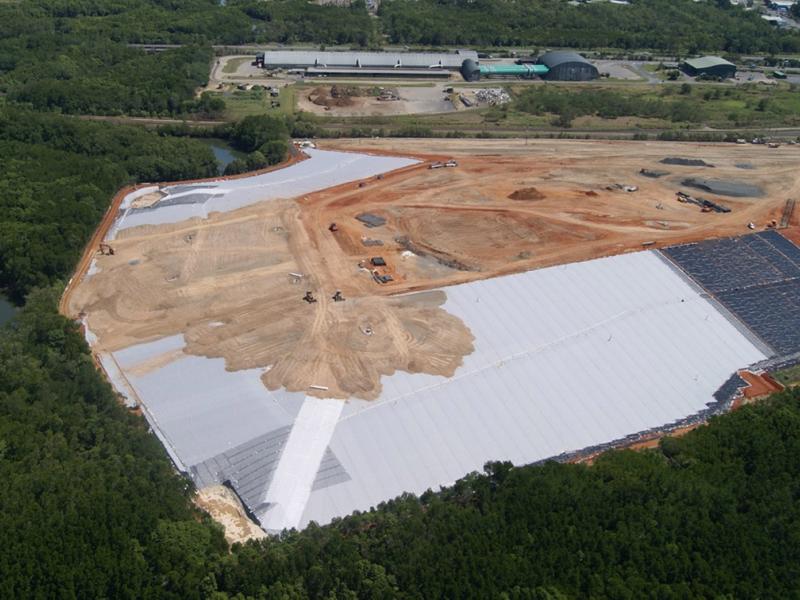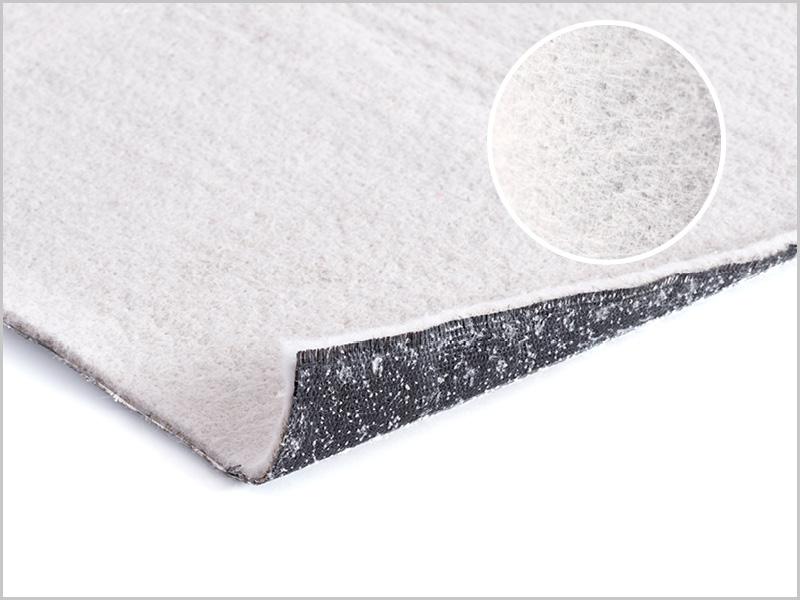
DESIGNING FOR BENTONITE EROSION ON SLOPES
The risk of Geosynthetic Clay Liner (GCL) Bentonite erosion when installed beneath exposed Geomembranes has been a regular topic in the public domain over the past few years. Based on studies at the Queens University QUELTS site, the conclusion is that if traditional GCLs are installed below exposed Geomembranes, daily temperature variations create an environment that leads to downslope bentonite erosion and loss of GCL performance.
The QUELTS study described certain GCL types that provided resistance to erosion and ensuing public discussion has focused on these product parameters in isolation. It is worth a review with some updated findings, to ensure that any design process implemented to solve GCL bentonite erosion, does not compromise long term performance of the hydraulic barrier.
The Composite Lining System
GCL erosion potential is primarily concerned with base lining systems in landfill and waste containments, where the aim is to restrict the passage of leachate into groundwater. The most efficient geosynthetic design option is a composite lining system that consists of a Geomembrane on top of a Geosynthetic Clay Liner (GCL). These are Composite lining systems because barrier performance is only achieved with an efficient interaction between the two layers.
Key Properties of the Geomembrane
Geomembranes are preferred as the primary liner because they are mechanically robust and present polymer options that have high chemical resistance if the correct base resin, density and crystallinity is established. HDPE is the first choice for chemical resistance but increasing density can impact mechanical properties like elongation to yield and make it more susceptible to Stress Cracking. LLDPE may have preferred elongation properties but might be more susceptible to chemical and exposure deterioration. Whatever polymer is selected, it is critical for the designer to understand this raw material, the range of additives and stabilizers that quantify longevity and consistency of the manufacturing source. In Australian EPA Guidelines, for most functions this is generally a PE Geomembrane of a minimum of 1.5mm thick, with properties for thickness, density, tensile, puncture, tear, carbon black content and dispersion, and elevated requirements for SCR, HPOIT and OIT testing.
Key Properties of the Geosynthetic Clay Liner
The critical parameters of the GCL are the same in terms of longevity of geotextile polymers, but now a mined bentonite component introduces a factor of variability that needs to be evaluated for clay mineralogy and consistency. For composite liners where hydration will occur via leachate, performance with site leachate as per the Victorian EPA Guidelines is critical because the primary hydration mechanism is the leachate itself. The guidelines also demand strict criteria to understand bentonite form and type, particle size, CEC and carbonate content and statements/demonstrated durability of polymers and pH modifiers when used with sodium-activated bentonites.
Dual Lining Systems
Note that dual Geomembrane lining systems are sometimes specified for high risk contaminants and ponds. These layers are designed differently to single composite lining systems, with leakage rates that consider holes in each Geomembrane in isolation. Leak volumes that enter the interlayer void require a geocomposite leak collection system installed between the liners to reduce accumulating hydrostatic pressures and acting heads, prevent HDPE whales and can capture leak volumes for analysis. To quote the irrepressible Ian Peggs: “if there is no leakage removal or management system, the secondary liner is a waste of time and money.”
GCL Bentonite Erosion and QUELTS
The mechanisms of GCL bentonite erosion have been well discussed but begin with a need to leave the composite liner exposed for a period of time. Daily temperatures cause the Geomembrane to thermally expand which results in wrinkle configurations that interconnect across rolls and downslope. Drips evaporate and condense on the underside of wrinkle causing local and eventually large scale migration of bentonite downslope. A laboratory method was developed to map the field conditions and was generally successful in demonstrating that alarmingly, most standard GCLs become compromised before 10 wetting/drying cycles are complete.
The key factors affecting down-slope erosion were identified in a series of QUELTS papers but 3 key findings were that:
- Covering the Composite Liner resulted in no observable GCL erosion
- A polymer enhanced (polyacrylamide) granular bentonite showed no evidence of erosion after 15 months in the field, yet observed irrecoverable erosion after 28 months due to possible polymer elution
- A multicomponent GCL with coating side up showed no evidence of downslope erosion in the lab or field.
A summary and recent developments in regard to these findings:
Covering the Composite liner
This is a key QUELTS observation and seen as the first design aim if achievable. For the geomembrane it eliminates UV degradation, and lessens expansion/contraction phenomena. For the GCL it facilitates intimate contact with the geomembrane, it encourages subgrade hydration and GCL erosion is not observed.
Multicomponent Coated GCLs
GCLs described as Multicomponent GCLs did not observe erosion throughout the QUELTS studies so have been postulated as a solution with the coating below the geomembrane. These are GCLs with a PP or PE coating of varying thicknesses (0.1mm - 1.0mm) applied to one side of the geotextiles on the GCL.
It must be noted that the use of a coating below the geomembrane presents as a substantial design change. It no longer allows a composite GCL/geomembrane action, and recent work by Abdel Razek and Rowe (2018) has reported testing of interface transmissivity under a range of stresses.
A key finding is that a textured coated GCL should not be placed against the geomembrane due to significant increases in transmissivity between the two layers. A smooth coating can act as a “good liner” at normal stresses of 50-150kPa, yet at low stresses higher transmissivities are expected. Hydrating the GCL via high ionic strength leachates observed high transmissivities at low confinements and steady state flow was not established for up to 6 months. This suggests that interface transmissivity for a GCL coating against the geomembrane is still a function of how efficiently it hydrates from the subgrade, the moisture content achieved, and hydrating water quality. A somewhat unique finding was when a hole was put in the coating, the transmissivity between the woven geotextile and the coating applied to it, was higher than that of the interface of the geomembrane coating itself. The authors describe more work being done in the field but highlight clearly that a smooth GCL coating is preferable and a need for further analysis.
If a smooth coating interface is now preferred below a smooth geomembrane it is potentially a low friction plane that allows the primary geomembrane to simply slide and engage in tension. A key design aim is to avoid this. Laboratory shears for design are tested by placing the interface in intimate contact, if we accept that primary geomembrane thermal expansion/contraction wrinkles will occur, it is unlikely that intimate contact will be observed and the risk of a low friction interface is high.
Polyolefins in the coating, should certainly be subjected to the similar longevity criteria that establish performance of geomembranes, as degradation presents a range of function and unknown stability problems both during construction and post closure. If a GCL coating is only 0.1-1mm thick, it is far below the range demanded of geomembranes for longevity (1.5mm+) and full polymer surface area is exposed. Stresses that thin this layer will simply facilitate both diffusive passage of contaminants and the primary modes of geomembrane degradation apart from UV are being observed, heat and cooling, oxygen and leachate leaks will cause unknown degradation on a polymer with unknown density, stabilizer packages and unknown stress behaviour. The GRI-GCL5 states that until longevity is established;
Note 4: Multicomponent GCLs might improve the performance over a standard GCLs in a specific application. However, they might only be suitable for short- or mid-term use.
And finally should a coated GCL-geomembrane interface be treated as a dual lining system that requires a geocomposite drain? It is the same configuration and design assumes leachate will enter the void. Without drainage, leachate will simply flow down the coating in the path of least resistance, hydrostatic pressure has potential to build and create whales in the geomembrane above and cause increased pressure on GCL overlaps. Our recent project experience tells us that the thicker coated GCLs that may be required for longevity (0.5mm min), even without a drainage geocomposite, will cost the same as a dual geomembrane system that has full PE analysis. It is likely simply more economical to go down the path of a dual geomembrane with a geocomposite drainage layer that is a well established design option.
Polymer Modified Bentonites
A conclusion at the end of the QUELTS studies in the Rowe et al 2016 paper that reviewed the GCL type on erosion, it was suggested:
“ a polyacrylamide polymer modified fine granular bentonite will perform effectively if covered before the polymer can potentially be washed out of the bentonite.”
Polymer Modified Bentonites are not without their challenges, but present an opportunity to design in the same as an ordinary composite liner if bentonite longevity is assured. It is technically wrong to analyze polymers alone; bentonite analysis needs to understand the raw material and all additives because each impacts the other. All GCLs in Australia contain additives to meet strict EPA Guidelines, pH modifier addition can be as detrimental as polymers if incorrectly proscribed. Suppliers should state categorically the additives that are included in their bentonites with demonstrated testing.
What has been overlooked in the QUELTS II erosion testing is that the powdered bentonites performed well in the field with minor erosion after 28 months, so it is not unusual that applying select additives to a quality raw powdered material might be considered good practice. Like every other geosynthetic component, it comes down to the right choice of polymer (we would not recommend polyacrylamide) but the quality of the bentonite source is the first understanding of performance.
An update from the Geofabrics GRID Laboratory is that performance testing designed to elute polymers has now exceeded 1,000 days immersion. This links to our ongoing library that includes 12+ site exhumations from GCLs (6 months to 17 years, up to 6 years for GCLs under exposed geomembranes), leachate compatibility testing from 30+ landfill sites (up to 240 days), 20+ different mine tailings liquors with multiple results above 600 days.
In terms of replicating QUELTS GCL erosion testing, Dr Will Gates PhD, Deakin University, author of the BPEM Vic EPA Landfill Guidelines – “Bentonite used in GCLs” has recently presented a paper at the 8th International Conference on Environmental Geotechnics in Hangzhou,China: “Resilience of Australian polymer-modified powdered sodium bentonite geosynthetic clay liners to downslope bentonite erosion”.
This paper has formed part of a Deakin University audit of our QUELTS erosion testing regimes with particular relevance to applying Australian site conditions. The analysis suggests that the QUELTS type erosion tests are likely relevant for GCL erosion and that for certain Geofabrics manufactured Polymer Modified GCLs, an expectation of up to 60 months of QUELTS equivalent conditions is likely onsite. This would provide a significant Factor of Safety based on current EPA demands for site coverage.
References
Abdel Razek, Rowe (2018) “Interface transmissivity of conventional and multicomponent GCLs for three permeants”. Geotextiles and Geomembranes 47 (2019) 60-74
Rowe, F.ASCE, Rentz, S.M.ASCE, Brachman, M.ASCE, Take, M.ASCE (2016) “Effect of GCL Type on Downslope Erosion in an Exposed Composite Liner. Journal of Geotechnical and Geoenvironmental Engineering, published online July 19,2016
Rowe, Take, Brachman, Rentz (2014) “Field observations of moisture migration on GCLs in exposed liners” 10ICG, Sept 2014




